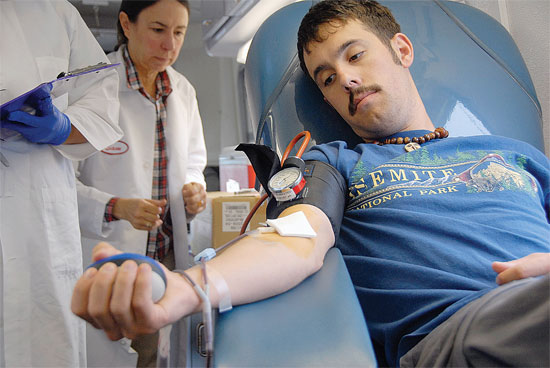|
|
|
 |
|
| Sally Medico looks on as Sean
Palmer makes a donation to the Northern California Community
Blood Bank. With women excluded from donating plasma and
platelets since November, men such as Palmer have stepped up
to fill the gap while at the same time continuing to donate
red blood cells. Joni Schrantz/The Eureka
Reporter |
| |
Calling all men and women:
by Carol Harrison, 4/29/2007
|
| |
The
Northern California Community Blood Bank’s mid-November decision to
exclude females from donating plasma and platelets may have
protected the safety of the blood supply, but approximately a third
of the female donors of plasma and platelets have not stepped
forward to donate whole blood.
“We work with a 10-day
inventory,” Donor Resources Director John Gullam said of red blood.
“When we get to the place where we’re starting to get concerned,
we’ll let people know. We’re still a few days away from
panicking.”
Gullam said getting the approximately 120 females
who previously donated plasma and platelets back into the fold to
donate whole blood is almost as much of a priority as attracting new
donors to meet the community’s needs.
“Our male donors have
really stepped up,” Gullam said. “We’ve been working our lists and
we’re calling them incessantly. Some are coming in once a week. But
we’re concerned about giving them some relief. We need more people
in the pool.”
Gullam said shortages in certain types vary,
with A+ and O+ being the desired donations as of
Wednesday.
To convince those on the sideline to step into the
blood donor pool, Gullam said, “Ask around. Most people know someone
who has received blood or a relative who has received it. Sometime
in your lifetime you will need blood products. It would be a shame
if they were not there for you when you needed them.”
Gullam
estimated 12,000 donors on record, but the 400 women who gave plasma
and platelets prior to their exclusion gave more than 61 percent of
the blood bank’s plasma and 30 percent of its
platelets.
“Some of the women have said they didn’t think
they could donate anything,” Gullam said. “The exclusion doesn’t
apply to whole blood.”
Gullam said “few, a very few” people
have become new donors since women were excluded in November. He
puts recruitment at the top of the list prior to the advent of
summer vacation schedules.
“We’re losing the baby boomers,
due to various factors associated with age and becoming less
eligible to give,” he said of the donor pool. “Generation X, their
children, are smaller in numbers, but we need a higher percentage of
them to donate to meet the need.
“The Y generation, the baby
boomers’ grandchildren, are getting to an age where they’re eligible
to donate in the next few years. They’re as big in numbers as the
baby boomers. It’s a large, eligible pool. That’s why high school
drives are so important.”
It’s also why the local blood bank
has established a presence on MySpace.com and why it’s researching
e-mail and text messaging as a way to contact the under-25
crowd.
“I saw recently where someone surveyed the 18 to
25-year-olds and did it all by cell phone because that’s where they
get their calls,” Gullam said.
E-mail and cell phone calling
to let donors know the blood bank is “low, very low or critically
low” has not started, but Gullam said it’s not far off.
“It’s
part of our focus on new donor recruitment,” he said. “That and
letting women know they can give whole blood.”
Red blood
cells can be donated every eight weeks or six times a
year.
Plasma can be donated monthly.
Platelets can be
offered weekly, but no more than 24 times in a year. They require 90
minutes to two hours to collect and are only good for five
days.
“People always assume there’s a shortage of the rare
types, but the percentage who need it is smaller, too,” Gullam said.
“Usually, it’s the most common blood type that is most
needed.”
An uncommon and previously undiagnosed condition
associated with the antibodies found in 15 to 20 percent of females
led to November’s exclusion of women from giving two of the three
components collected by the blood bank.
According to the July
2006 issue of Blood Bulletin, transfusion-related acute lung injury
occurs within the first six hours of transfusion. TRALI has been
linked to an antibody in only 1 percent of males, but has been found
in women who have been pregnant or had transfusions.
First
described in 1985, it has emerged as the leading cause of
transfusion mortality in the U.S. as other adverse reactions to
transfusions have decreased with improved donor screening and blood
product manufacturing.
There is no screen currently available
to test for the antibody tied to TRALI. When the donated blood with
the HLA antibody interacts with the cells of those receiving the
donated transfusion, potentially fatal respiratory distress may
result.
For more information or to become a donor, go to http://www.nccbb.org/
or phone 707-443-8004.
| |
|
|